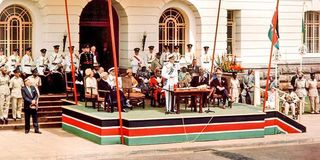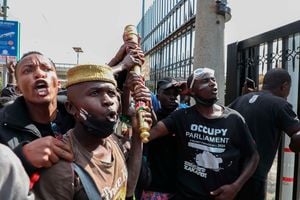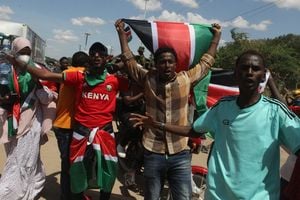Class struggle in Kenya and search for ‘uhuru’

Prince Philip of Great Britain speaks while Prime Minister Jomo Kenyatta (right) listens during the ceremony of the declaration of Kenya’s independence in Nairobi on December 12, 1963.
The thrust of the anti-colonial struggles in Kenya was the economic and political liberation of Kenyans. Kenyans, especially Africans, wanted to be free of racism, economic exploitation, social exclusion and alienation, and political marginalisation.
They didn’t want to be third-class citizens in their native land. Kenyans — and this included people of other races who had been born in colonial Kenya or had stayed in the country long enough to belong — wanted a country where every citizen, irrespective of their colour, class, creed, or culture had the right to a decent life, right to own property, work and live wherever they wished in the country, and was respected as a human being.
One only needs to read the original Kanu manifesto to appreciate how Project Kenya was imagined. Kanu declared that its main goal in the fight for independence was ‘the goal of all indigenous people of Kenya ... independence’; Kanu declared that it believed ‘in the fundamental rights of the individual’.
While in power Kanu stated that ‘the individual must enjoy political and economic freedom. Kanu will ensure employment, protect the citizen against long hours of work and ascertain a minimum wage which could afford the worker clothing for himself and his family, decent food, education for his children, a little comfort and leisure.’
All this is found in Two Paths Ahead: The Ideological Struggle between Capitalism and Socialism in Kenya, 1960-1970 by Shiraz Durrani (Vita Books, 2023).
Of course, like all liberation movements, Kanu would later renege on most of these lofty promises. The party would drop its pretensions to Africanism (however it defined such) and African Socialism, and morph into a fully capitalistic party. Its (new?) ideology would progressively separate the party from its cadres and the rest of Kenyans, as well as some neighbouring countries, and many of its international supporters.
Kanu became two parties in one, A and B. Kanu-B (the capitalists) would win the battle for the soul of the party, with Kanu-A members being scattered through assassination, imprisonment, exile, resignation, expulsion from the party and co-optation.
In Two Paths Ahead, Durrani reminds the reader that the Kanu Manifesto, which was released in 1960, ‘was inspired by the militant forces from the trade union movement.
Socialist phrase
Thus, the Manifesto reflected the socialist phase of Kanu, before Jomo Kenyatta, Tom Mboya and others turned the party into Kanu-B. The active hands of the USA and United Kingdom, through their ambassadors, governors and High Commissioners were behind the party’s embrace of capitalism and its rejection of socialism.’
Indeed, Kanu, which had replaced the proscribed Kenya African Union, had drawn its inspiration from the aspirations of the men and women who went to the forest to fight for their freedom and land, as well as trade unionists with the support of international friends.
It is not surprising that the ‘Manifesto was printed in Cairo by the Dar El-Hana Press’ — because ‘colonial policy did not allow easy access to printing facilities for liberation forces.’ Durrani notes that the Manifesto was a collective document, which ‘reflected the views and wishes of the entire party membership.’ He further writes, ‘it was presented to the people of Kenya at a mass rally, indicating that the party was democratic and got its legitimacy from the people.’
Yet, after attaining power, the party gradually moved away from its pro-people ideology of pre- and immediate post-independence moments and established policies and institutions that would guarantee that Kenya trod the capitalistic path in later years.
For instance, the party and the government, according to Durrani, became less concerned about land redistribution, considering that land was the major factor in the Mau Mau war of liberation, and was still a major factor of production for the majority of Kenyans.
Kanu and the government didn’t resettle or compensate individuals who had been forced off their lands by the colonial government or those who had gone to fight in the Mau Mau but on returning they discovered that their lands had been appropriated by the government and its collaborators.
But why should Kenyans be bothered about the history of Kanu, its internal struggles and the winners in that fight for its control? First, because Kenyans today live with the consequences of Kanu’s decisions in the 1960s. What the party leaders then did about the economy, politics, education, culture, nationalism, foreign policy etc affect what Kenya and Kenyans are today. How?
Land issue
Consider the question of land. Today, there are claims that a few individuals acquired huge tracts of land, legally and illegally. That these persons sidelined poor Kenyans who had lost land or had little or none. That ‘landed gentry’ became the future capitalist class in Kenya since they carried on the colonial economic policies of producing crops for export.
Is it surprising that postcolonial Kenyan governments have never seriously considered industrial innovation and production for economic progress? How would a class that was politically and economically nurtured to think about how many acres of land it has – today it is how many blocks of apartments – would think seriously and creatively about education, innovation and industrial production?
Land will remain emotive, throughout the country as the population grows but with little or no gainful employment opportunities. It is not surprising that today politicians are still promising young Kenyans economic freedom through business and employment – hustlers are being told that they will have a share of the national cake if they work hard. These promises are not much different to the ones of the independence moment when poor Kenyans were promised economic freedom yet denied access to productive land. This is history repeating itself, literally.
What Durrani offers in Two Paths Ahead: The Ideological Struggle between Capitalism and Socialism in Kenya, 1960-1990 is a provocative discussion on what went wrong, how the pro-people policies framed in the Kanu Manifesto of 1960 were bastardised and why it has always been difficult for progressive individuals and institutions in Kenya to succeed in the struggle for true liberation of the country from neocolonialism.
Durrani references bits and pieces of Kenyan history in the 10 years, just before independence and the consolidation of the nation-state under Kenyatta 1, that stand out as key moments in the transformation of the country into a capitalistic society; moments that today are fading from public memory and have little by little been erased from the school syllabi.
These are the moments that Kenyans who truly believe that Kenya could one day become a socialist state – as the Kenya People’s Union and other post-colonial movements that have fought for freedom and socialism did – that is inclusive and fair to everyone must not only hold on but transmit to future generations. For those today who wish to know where and when the ‘rain started beating Kenyans’, reread the history of those tumultuous 10 years when what is today casually called ‘state capture’ happened.
Tom Odhiambo teaches literature, performing arts and media at the University of Nairobi. [email protected]




